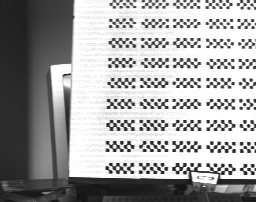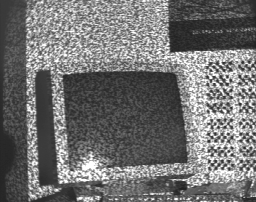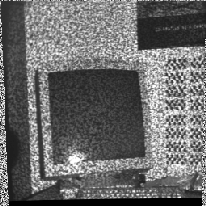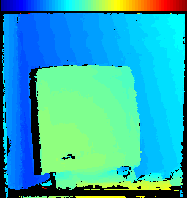Go to: [Up |
Next (Comments) |
Back |
Table of Contents]
Each segment of the full view is split in several partial scans. Each
of them starts at the corresponding landmark. The views of each
partial scan are registered with the help of a registration aid. For
each view a sequence of images is taken as follows.
 | 
|
registration aid
to register with previous view
| superimposed random texture
projected from a slide-projector
|
|---|
 | 
|
| natural texture and shading
| registration aid
to register with next view
|
|---|
The points on the registration aid are uniquely indexed but their
position within the target or the target geometry and/or position
and/or orientation need not be known to recover the
transformations. The indices are decoded in an automatic detection
procedure, the 3-D points are then reconstructed by stereo
reconstruction and the 3D rigid transformation between two sets of 3D
points (before and after the motion) is recovered by an absolute
orientation procedure.
The artificially textured scene images were processed per pairs as follows:
- Rectification standardizes (reprojects) the 512 x 512
images from any camera pair so that the 256 x 256 rectified images
appear to be from a left-right pair of non-verging distortion-free
cameras.
 | 
|
| 512 x 512 images before rectification
|
|---|
 | 
|
| 256 x 256 images after rectification
|
|---|
- Matching recovers integer disparity map. Matching is
left-right, right-left symmetric and uses forbidden zone constraint to
select matches from high-correlation candidates. Modified normalized
cross-correlation is used. Matching is done pairwise (which can be
done in parallel). Just 4 image pairs out of 6 possible were used for
matching.
- Sub-pixel disparity correction is then computed using an
affine model of apparent distortion between the left and right images.
The correction is estimated from image derivatives and image values
using LS estimator and is invariant to scaling and offset in image
intensity. This step gives the reconstruction the high precision and
geometric accuracy.

|
sub-pixel disparity map
(holes and occluded areas are black)
|
|---|
- Fusion All disparity maps from all four pairs in a view
are re-mapped to the disparity space of a selected (always the first)
pair. The same selection procedure that was used for selecting good
matches is applied again. The result is a much cleaner disparity map
with less holes and less outliers. This step effectively fuses all the
disparity maps.

|
| fused disparity map
|
|---|
- Reconstruction converts the fused disparity map to 3D
points in Euclidean space.
- Point coloring assigns the reconstructed points color by
reprojecting them to the color camera image plane and retrieving the
appropriate color with bilinear interpolation.
- No manual editing in any stage of the process was done, no
outliers removal, no filtering, no additional registration.
Go to: [Up |
Next (Comments) |
Back |
Table of Contents]
Radim Sara
Last modified: Fri Nov 7 17:12:51 MET 1997













